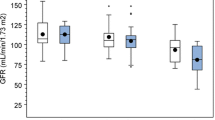Abstract.
The objective of this study was to determine the frequency with which urinary tract infection (UTI) in the absence of concomitant underlying abnormalities caused end-stage renal disease (ESRD). The records of 102 patients with ESRD (disease necessitating dialysis and/or transplant) seen at Children’s Mercy Hospital during a 10-year period (1986 – 1995) were reviewed. Obstructive uropathy, aplastic/hypoplastic/dysplastic kidneys, polycystic kidney disease, congenital nephrotic syndrome, acquired glomerulonephritis, idiopathic interstitial nephritis, hemolytic uremic syndrome, and a variety of systemic conditions were the cause of ESRD in 99 children; 3 children had reflux nephropathy, 1 of whom had no history of a UTI and another who had a single, afebrile UTI. A girl with a history of recurrent UTIs since 4 years of age had an elevated serum creatinine and grade II – III bilateral vesicoureteric reflux when evaluated at 8 years of age. She had ureteral reimplantations and control of the infections, but progressed to ESRD. This child appears to be the only 1 of 102 children who developed ESRD because of acquired renal injury in which UTIs were an important contributing factor.
Similar content being viewed by others
Author information
Authors and Affiliations
Additional information
Received July 29, 1997; received in revised form October 22, 1997; accepted October 26, 1997
Rights and permissions
About this article
Cite this article
Sreenarasimhaiah, S., Hellerstein, S. Urinary tract infections per se do not cause end-stage kidney disease. Pediatr Nephrol 12, 210–213 (1998). https://doi.org/10.1007/s004670050439
Issue Date:
DOI: https://doi.org/10.1007/s004670050439




